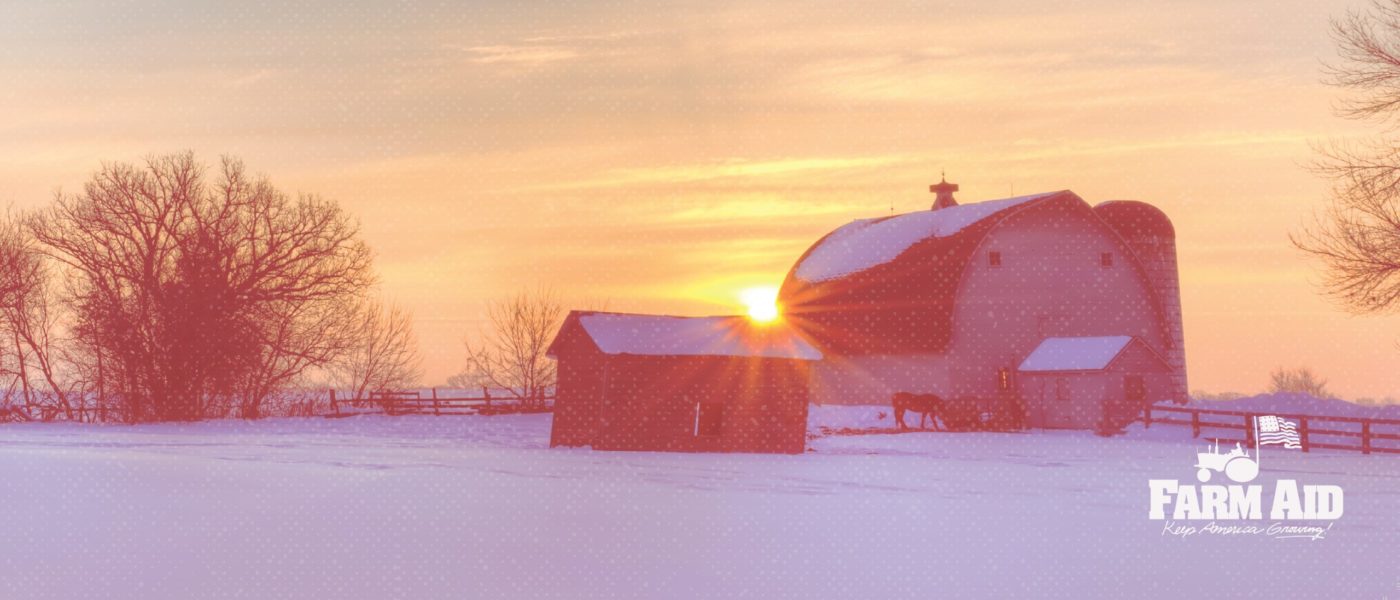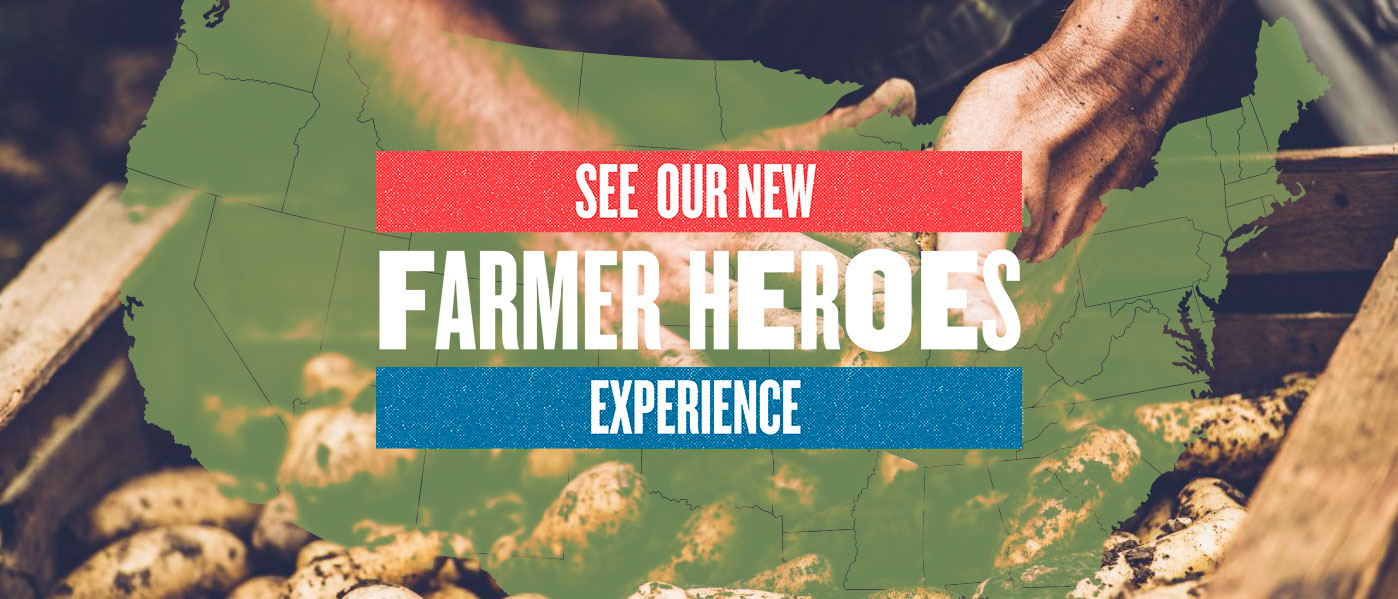Hardwick, VT
Steve and Patty Meyer began raising beef cattle in Hardwick, Vermont, in the 1960’s and transitioned to dairy farming in the late 70’s. They raised four boys on their family farm, including their youngest Nick Meyer. In the early 2000s, the family made the decision to transition to organic production, and in 2003, Steve and Patty decided they were ready to pass on the day-to-day work of the farm. Nick and his older brother Taylor stood ready to take the reins. To avoid their land being split up and sold, Nick and Taylor decided to operate the farm together. Nick explains, “We saw the land as a huge value that we wanted to save.”
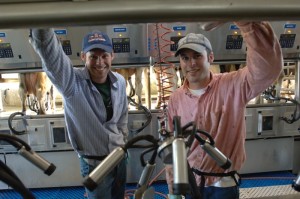 Today, Nick and Taylor own and operate North Hardwick Dairy, with Steve and Patty working part time, doing milking and haying. The Meyers have a herd of 110 head and 300 acres for pasture and hay crop. The crops include legumes, grasses, orchard grass and red clover, all of which is transformed into round bale hay to sustain the herd during the winter months when they are unable to graze on pasture. The Meyers also grow peas and oats as forage for their herd. Their most recent addition to their farm is sunflowers, which the Meyers use to produce their own on-farm energy. The milk produced on the farm is picked up every other day by Organic Valley Co-op and most of it goes to a New England yogurt company.
Today, Nick and Taylor own and operate North Hardwick Dairy, with Steve and Patty working part time, doing milking and haying. The Meyers have a herd of 110 head and 300 acres for pasture and hay crop. The crops include legumes, grasses, orchard grass and red clover, all of which is transformed into round bale hay to sustain the herd during the winter months when they are unable to graze on pasture. The Meyers also grow peas and oats as forage for their herd. Their most recent addition to their farm is sunflowers, which the Meyers use to produce their own on-farm energy. The milk produced on the farm is picked up every other day by Organic Valley Co-op and most of it goes to a New England yogurt company.
During the springtime Nick works many long days. Depending on the weather, mid-May is typically the time to begin haying. Unfortunately, this year has been anything but typical, due to heavy rain. “It has been a crazy year, with the wettest spring on record,” Nick explains. Typically their sunflowers are put in the ground around May 20th but because of the conditions they are a couple weeks behind this year.
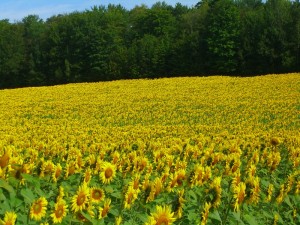 The value and health of the land and the product it produces is very important to Nick and his family. They believe as a family that the root of farming begins in the soils. As they put it, “If our soils are good then the crops we grow are strong. Great crops translate to healthy cows and healthy, happy cows mean the best quality milk anyone can buy. Organic farming has allowed our family to do all this and provide a greater lifestyle. Increased cow immunity, increased land purity, increased profits.”
The value and health of the land and the product it produces is very important to Nick and his family. They believe as a family that the root of farming begins in the soils. As they put it, “If our soils are good then the crops we grow are strong. Great crops translate to healthy cows and healthy, happy cows mean the best quality milk anyone can buy. Organic farming has allowed our family to do all this and provide a greater lifestyle. Increased cow immunity, increased land purity, increased profits.”
One of the sustainable methods Nick takes great pride in is wide swath hay, also known as ‘Hay-in-a-Day.’ This haying technique involves mowing the field in the morning without cracking the stem and returning in the afternoon to pick it up. This method allows the sun to dry the hay while sugars and nutrients are produced throughout the day; as Nick explains, “You can’t dry laundry in a pile.” As a result of this technique, the hay has a high energy and nutrient content, which gets passed on to the cows that eat it. This high quality hay leads to the farm’s award-winning milk, which has received multiple honors as the highest quality milk in the state of Vermont.
The Meyers’ drive for quality and sustainability goes far behind their soil, hay and milk. They have installed innovative on-farm renewable energy production methods to help power their farm and take good care of the environment.
The first step toward energy development came in 2005, when Nick began producing biodiesel fuel from used vegetable oil. In 2007, Nick and his brother installed a 10 Kilowatt wind turbine on their land to produce energy from the wind. And three years ago, they began growing sunflowers and have been successfully producing sunflower oil and biodiesel fuel for about a year. The beauty of this method, Nick explains, is that the sunflowers produce two beneficial products. The first is the oil, which can be made into fuel, and the second is a high protein sunflower meal. Nick feeds this meal to his calves that have just come off the milk of their mothers and to heifers. Nick mixes the meal with grains at a ratio of 50/50; as Nick explains, “The high protein gives the calves an extra boost for growing.”
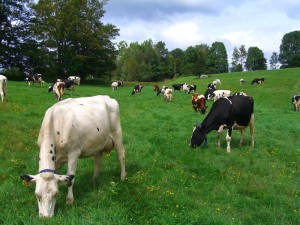 In the winter Nick uses the biodiesel produced from the sunflowers in his barn’s furnace for hot water and heat. During the warmer seasons the biodiesel is blended in a ratio that ranges from B20 (20% Biodiesel) to B50 (50% Biodiesel) for their farm equipment. “Each year we are getting better,” says Nick, and he has been able to cut his fuel purchases. Because Vermont is a colder climate, Nick explains that his farm would never run 100% on his biodiesel fuel but he predicts that in the next few years 75% of his farm will be run off the by-product of his sunflowers.
In the winter Nick uses the biodiesel produced from the sunflowers in his barn’s furnace for hot water and heat. During the warmer seasons the biodiesel is blended in a ratio that ranges from B20 (20% Biodiesel) to B50 (50% Biodiesel) for their farm equipment. “Each year we are getting better,” says Nick, and he has been able to cut his fuel purchases. Because Vermont is a colder climate, Nick explains that his farm would never run 100% on his biodiesel fuel but he predicts that in the next few years 75% of his farm will be run off the by-product of his sunflowers.
Economically it has made a lot of sense to run equipment off biodiesel. It costs Nick 99 cents a gallon to plant, harvest, dry, clean and press the sunflower crop and produce oil. After the process of refining the oil into fuel it costs less than 2 dollars a gallon, which, compared to the prices at the pump, is a very significant savings.
Nick’s advice to other farmers interested in producing their own energy is to connect with their local environment and neighboring farms. Forming a cooperative or creating a connection with other farms in the area is one way to share the labor of growing, cleaning, combining and pressing the crops into oil. Nick says that grain farmers have most of the equipment needed to undertake biodiesel production with the addition of a press and seed cleaner. But, he says, “Joining in with other farmers would be a great way of doing it because it is quite an undertaking as far as equipment goes.” In Vermont there is a small community of about 10 farmers producing their own oil.
Nick thinks the most unique initiative at the North Hardwick Dairy farm is their sunflowers. He explains, “The sunflowers are definitely an eye opener for people in Vermont—there is a lot of positive talk and reaction to them.” Nick and his brother have put a lot of time, work and effort into sustainable farming and producing great quality milk. Their values and techniques are inspirational environmentally and economically and as Nick exclaims, “It’s definitely worth it.”
Further Reading
- Have you heard about “hydrofracking”? Check out this month’s Ask Farm Aid to read about a process that is quickly becoming more commonplace on farmland and rural areas to extract natural gas from deep underground. An alternative to oil and coal, but is it a good thing, and for whom?
- In Putting it into Practice, our staffer looked at the available alternative fuel options, what it takes to make his car run on waste vegetable oil and what advantages it offers.
